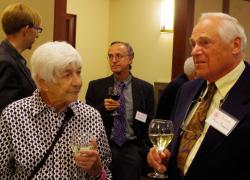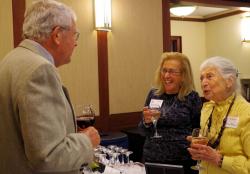 Minutes of CAAS Meeting 1446: Todd Ahern, Professor, Quinnipiac University
Minutes of CAAS Meeting 1446: Todd Ahern, Professor, Quinnipiac University
The Regular Meeting opened with the introduction of Hans Bergmann who introduced the speaker from Quinnipiac University. The speaker is using an animal model to study human behavior. What is inside our brains? Todd Ahern is a distinguished professor with appointments in several departments including the medical school. He is studying family structure and behavior in prairie voles.
In nature, monogamous prairie voles experience considerable natural variation in early social attachment opportunities because of differences in family structure [e.g., single-mothers (SM), solitary breeding pairs, and communal groups].
Todd Ahern: The topic today is family life and insights from voles.
Voles often have a monogamous relationship sometimes similar to various cartoon families. Family on any level is complicated and poses interesting questions. Do family practices influence development of brain.
 How does variation in early life result from or influence brain development?
How does variation in early life result from or influence brain development?
These are questions to be addressed today. Our early evidence suggests the way we behave in our family can influence brain development. Unstable situations produce social deficits. Lots of variables to consider. All that variation can influence behavior. Science has looked at a lot of models including non-human primates. But, there is limited variation to be examined in the existing laboratory models. So, here are the prairie voles. They adapt well to the laboratory. Exhibiting care of others, they bond with mates, so males contribute to care of infants.
How are their offspring reared?
One third in groups, one third in family, and one third by single mother. There is also variation in behavior. Some are monogamous. 60% show monogamous family behavior.
How do they behave in family settings? Can these behaviors be related to obvious differences in the brain?
There is variation in family structure among voles. Some slight parallels with humans. We want to see if there are brain differences in high level versus low level of care.
We studied licking and grooming among these rodents. How often does this go on?
We made efforts to quantitate this. Mother versus father in licking and grooming. How often are pups alone in nest? Does the mother change behavior to compensate for absence of the mate. How often are pups alone? The answer is very rare in monogamous pairs. But, in single mother conditions, pups are more alone often.
Among humans, parents coordinate care of young. Do rodents coordinate?
Apparently. The female will grab the male by a leg and drag him back. In bi-parental conditions, there is more licking and grooming. Females more than males. But males are doing something else, taking care of female. More time taking care of himself.
How does the parental care influence the young after they become adults?
What we see is that among the test animals how they are raised doesn’t matter. Except that females of a single mother don’t spend as much maternal time as bi-parental females. Males are less affected.
 How well do they bond as adults?
How well do they bond as adults?
24 hours are required to determine bonds. A 3-hour test is required. A computer was used to calculate different behaviors.
What does the bonding behavior look like?
Bi-parental test animals spend more time with partner. Those of single animal origin don’t show as much preference. After a week, all can form a bond. Single mothers as well as others. We found single mothers lick and groom but at a lower level. Is there something going on in the brain that regulates this behavior?
We looked at neuropeptides in the brain including oxytocin specifically. Are there differences in receptors using autoradiography? Does receptor density vary with early life experience?
We studied bi-parental animals versus single mothers. Does variation at level of receptor predict behavior. Hypothesis was that the more receptor, more bonding. Not in the ventral forebrain. We did not find a correlation. Therefore, receptor is only one-half of this process.
We also looked at the genetic diversity among voles. Chinese voles show similar findings to our prairie voles. Different behavior in Mandarin voles. Lots of variation across species.
Come back to idea that early life affects oxytocin receptor expression. Turns out that some DNA sequences are variable. So genotype does affect receptor density. Are low levels more susceptible to early life variation.
High receptors were correlated with more bonding. We could break apart by genotype so there is a gene influence on bonding, single versus family.
 These are preliminary data. Does the genotype influence outcome of early life experience?
These are preliminary data. Does the genotype influence outcome of early life experience?
The answer is only in this one area of social behavior.
How can we use this information to learn when an animal might be vulnerable?
Goal is to be able to apply this to humans. Not there yet.
Question:
Thanks for this talk that shows value of research. Shows there might be another regulatory mechanism, regulation of gene expression.
Answer:
Yes, great question. Might be some epigenetic factor.
Question:
Is huddling a euphemism
Answer:
Sometimes, yes. Sometimes, not. There is a period of significant mating. But, not always.
Question:
What about those traumatized. Transmission of trauma?
Answer:
This model was developed to avoid the issue of trauma. Others are looking at this question in rats watching corticosteroid levels. Seems to be some epi-genetic factor.
Question:
Good basic science report at 15 years in the academy
Answer:
Glad everyone is still sitting down.
Question:
Regular behavior after weaning? Is that a factor?
Answer:
High investment results in prolonged family structure.
Question:
What happens if snake eats a mother?
Answer:
After 21 days, older will compete with young offspring. Has not been teased apart.
Question:
What are your thoughts on what we should be doing in parenting?
Answer:
I feel I’ve just been thrown in a snake pit? What does it mean to be a good rearing parent? In a war zone, greater care can be either good or bad. No clear answers.
Question:
When you have genetically vulnerable population, is there a corrective mechanism.
Answer:
Complex. Bonding occurs at lower level. Don’t know the answer yet.
Final Comment:
The Fox and the Vole. A parasite regulates the population of both voles of foxes. Echinococcus multilocularis, a tapeworm kills foxes. Voles commonly sustain an inapparent infection. This is a classic population study. Foxes feed on infected voles and begin to die. Then the vole population begins to increase. It’s cyclic mediated by the parasite.
Minutes by Monica Aspianto